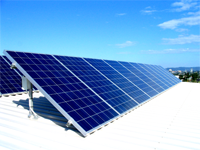Solar Power


KOPS International Limited is a leading industry in the renewable energy sector in India. Renewable sources of energy are quickly replacing the traditional sources of electricity due to no unknown reasons such as environmental pollution, fuel price hikes & rising electricity bills. KOPS provides better option through Solar Powers, which is largely preferred due to economical and environmental benefits over the public utilities. Solar Power has been used from ages in some or the other form but the technology to convert this energy into electricity has gained acceptance and momentum by the industries recently.
The Solar Energy can be directly converted into electricity using photovoltaic’s (PV), which provides electricity free of cost after the installation. The electricity generated from the panels can be used instantly or stored for future purpose or there could be a combination of consumption through Solar Powers & government power supply grids.
The solar power Solutions are available in different modes as mentioned below:
Model 1-
Generate and Consume. No Storage
Case-1 Generated Solar Power sufficient for required load
In this case, the energy is generated completely by the solar panels, which is sufficient as per the requirement and there is no need to consume from the power supply grid.
Case 2-
Generated Solar Power not sufficient for required load. In this case, the energy generated from the solar power is not sufficient as per the requirement. Hence, power is drawn from the power grid especially during the night time. During the day, the power is extracted from solar power and when sun is not that bright, that is during the night time it draws the required power from the grid.
Model 2- Generate and Consume with Storage
In this model, the solar power is both consumed as well as stored for the future usage.
Case- 1
Solar Power more than required load. Battery not fully charged. Grid power not required.
In this case, the power generated is enough as per the requirement, hence, no need to draw electricity from the power grid.
Case- 2
Solar Power less than required load. Battery not fully charged. Grid power required.
In this specific case, the electricity generated by the solar panel is not sufficient as per the requirement, hence, the remaining requirement is fulfilled with the electricity drawn from power grid.
Case- 3
Solar power less than required load. Battery fully charged. Grid power available.
In this case, the power generated is less than the requirement, hence, the lack of power is accomplished through the supply from the power grid.
Case- 4
Solar power less than required load. Battery charged. Grid power not available.
In this case, there is no power during the day time because the electricity generated through solar panel is stored in the battery and used during the night time. The power grid supply is not available.
Case-5
Solar power not available. Battery charged. Grid power not available.
In this case, the solar power is not available, neither is the supply from power grid and the only source of power being the battery.
Model 3- Generate. Consume. Sell.
In this model, the power generated through the solar panel satisfies
the requirement of the power for consumption as well as it generates
stock in excess for selling as well.
Features:
- Surplus solar power generated is passed to the grid
- Concept is called Net Metering
- Net Metering policies are governed by State Governments
- Not all the states have Net Meter policy defined
- Bi-directional meter is used to measure inflow and out-flow.
- The billing is based on the net energy imported (energy consumed minus energy generated and fed into the grid).











